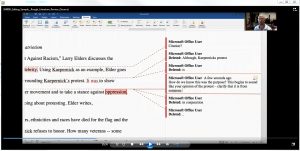
Media Is Everywhere.
In 2017, a thirty-second Super Bowl ad cost companies around five million dollars, or a mere $166,667 per second. If you have a teenager like I do, then you have possibly witnessed them watching someone else play video games on YouTube. Who knew that was even a thing? The most popular gamers, or “content creators”, on YouTube earn anywhere from 7-15 million dollars annually, and Cisco estimates that more than eighty percent of all internet traffic will be through video in 2021.
Media, defined as video, graphics, interactives, audio, etc., is in demand and acts as a vehicle to engage, excite, entertain, as well as educate. Therefore, it’s only natural that online learning would leverage media usage. So why don’t more online programs incorporate and utilize media?
The answer is simple: many institutions and faculty simply don’t know how to create and use video, or don’t think they can afford it. Luckily, the secret sauce for compelling media is actually very simple:
- a pinch of initiative
- a dash of technology
- a sprinkle of creativity
- a handful of team effort
Through media, educators can create connections between themselves, the learner, and the content. Media enables a seamless transfer of knowledge and the cultivating and fostering of a learning community within the online classroom. It also has the ability to create connections, allow both the students and faculty to become storytellers, and clarify difficult concepts through visual tools. Given the choice between a learning experience that incorporates video, podcasts, and games, and one that only features text on a page, which would you prefer to digest?
No Budget? No Problem.
Regardless of their budget, universities can incorporate media into their curriculum. Schools without a specified media budget should not be discouraged, as they can create it in a cost-effective way as long as they have a great idea, willing “talent”, recording devices (think smart phone or iPad), stock editing software (movie maker, iMovie), time, and patience.
See below for five simple ways your institution can start effectively incorporating media into your courses:

GET OUT


BRING IT FULL CIRCLE

DON’T UNDERESTIMATE THE POWER OF VIDEO


SHOW OFF


IT’S ALL ABOUT WHO YOU KNOW
Are you ready to start incorporating more media into your courses? Below are a number of resources to help you get inspired:
In sum, budget and expertise shouldn’t dictate whether or not your courses feature different types of media to better engage students. Try these recommendations and see the difference for yourself.
For more tips and strategies to increase learning engagement, see our resources page.

















